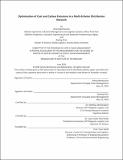Optimization of Cost and Carbon Emissions in a Multi-Echelon Distribution Network
Author(s)
Benhassine, Amina; Shan, Boping
DownloadOptimization of Cost and Carbon Emissions in a Multi-Echelon Distribution Network.pdf (647.3Kb)
Metadata
Show full item recordAbstract
Over the past decade, the oilfield services industry has experienced two major trends: the drive to reduce costs and the push for sustainability. In this context, our sponsor company seeks to optimize the distribution of materials and supplies in their global network, while considering both distribution costs and greenhouse gas (GHG) emissions. Our project has three objectives. The first is to develop an optimal transportation plan for materials and supplies – through the network of suppliers, manufacturing centers, distribution centers, and field warehouses – simultaneously minimizing distribution costs and GHG emissions. The second objective is to estimate the potential cost and GHG emissions reductions the company could achieve by bypassing the manufacturing centers for the eligible parts. Finally, our project aims to provide a deep understanding of the trade-offs between distribution costs, GHG emissions, and lead time. To achieve these objectives, we built a Mixed-Integer Linear Programming model that minimizes distribution and GHG emissions costs under demand and maximum lead time constraints. Our model provides an optimal transportation plan that recommends the quantity and mode of transport throughout the echelons of the network for all parts in scope. Our results show that bypassing the manufacturing centers could lead to a 3.7% reduction in distribution costs and a 1.7% reduction in GHG emissions. Moreover, our results show that most of the distribution cost reduction is due to the reduction in duties and that a small number of parts accounts for most of the cost savings. Finally, by varying the weight assigned to the distribution cost and to the GHG emissions cost in the objective function, we demonstrate that the company can achieve quick wins in emissions reduction.
Date issued
2023-09-08Keywords
Supply Chain Management, Distribution, Emissions